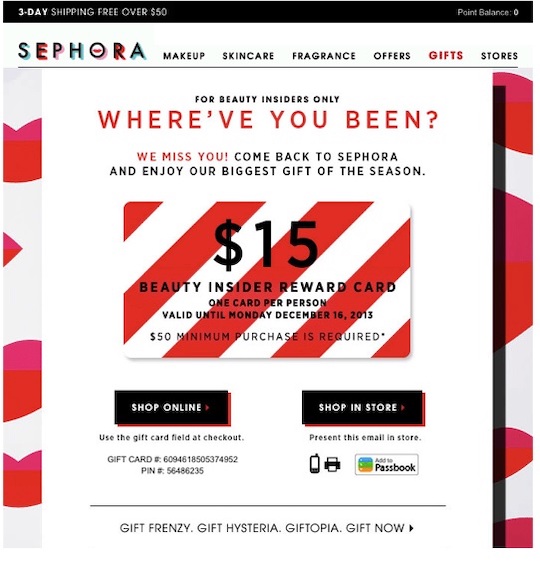I often write about the value of email data. Email marketing continues to be an effective way to drive sales for ecommerce merchants. An active and deliverable email address can contribute significant dollars to your bottom line.
Every email database has hidden opportunities in my experience. I’ll address those opportunities in this post.
Hidden Opportunities in a Subscriber List
Lapsed subscribers. Subscribers come and go. Ecommerce companies often clean-up their lists, wherein subscribers who have not purchased in, say, 12 months are removed from the “active” database and no longer receive marketing promotions.
But customers who have not purchased in a while can resurface and buy again. Thus it’s critical to revisit lapsed subscribers with a strong message and offer to win them back.

Sephora’s win-back email includes a $15 reward card.
Bounced or undeliverable emails. Email deployments typically have a handful of hard and soft bounces, as well as other undeliverable emails. It’s essential to understand how your email marketing provider defines hard and soft bounces and other undeliverable addresses. Most providers automatically remove hard bounces (address no longer exists) from your files. Similarly, soft bounces (full mailbox; temporarily unavailable) are eventually removed after several attempts.
The policy of automatically removing bounced emails helps with deliverability and reputation by keeping your list clean. But many of these email addresses are still representative of consumers who likely want to receive emails and purchase from you. Perhaps their address changed, or they experienced a temporary disruption.
Thus, periodically review all bounced or undelivered emails using an email verification service to determine which are still valid. Then try a small deployment to the confirmed addresses and reinstate all that are deliverable.
For undeliverable emails, run a change-of-address process through a provider such as Fresh Address, to obtain a new address, if applicable. When consumers change emails, they don’t typically update all subscriptions, especially from online retailers. Do whatever you can to retain active addresses.
Partner data. Co-marketing campaigns can be effective for merchants and customers. For example, a recipe site could partner with a gluten-free pasta company. The recipe site offers gluten-free pasta to its subscribers while the pasta company offers recipes. Look for co-marketing opportunities with relevant partners to reach new prospects and expose complementary brands to your subscribers.

Rite Aid co-markets with leading consumer goods companies, such as Cheetos and Capri Sun.
Demographic or behavioral data. Use demographic information about your subscribers to personalize messages, segment your file for relevancy, or send timely emails based on activity. For example, you can send a birthday message to subscribers if you have that info. If you know the gender of subscribers, separate offers for men and women.
The more relevant the message, the higher the opens, clicks, and conversions. Use data to your advantage.
Data append. Your email database may not include a name and postal address. But the more info you know about a subscriber, the better. With just an email address you can obtain from a data append service a name and postal address. Conversely, with a name and postal address you can likely get an active email address.



